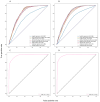Early Detection of Dementia in Populations With Type 2 Diabetes: Predictive Analytics Using Machine Learning Approach
- PMID: 39434474
- PMCID: PMC11669872
- DOI: 10.2196/52107
Early Detection of Dementia in Populations With Type 2 Diabetes: Predictive Analytics Using Machine Learning Approach
Abstract
Background: The possible association between diabetes mellitus and dementia has raised concerns, given the observed coincidental occurrences.
Objective: This study aimed to develop a personalized predictive model, using artificial intelligence, to assess the 5-year and 10-year dementia risk among patients with type 2 diabetes mellitus (T2DM) who are prescribed antidiabetic medications.
Methods: This retrospective multicenter study used data from the Taipei Medical University Clinical Research Database, which comprises electronic medical records from 3 hospitals in Taiwan. This study applied 8 machine learning algorithms to develop prediction models, including logistic regression, linear discriminant analysis, gradient boosting machine, light gradient boosting machine, AdaBoost, random forest, extreme gradient boosting, and artificial neural network (ANN). These models incorporated a range of variables, encompassing patient characteristics, comorbidities, medication usage, laboratory results, and examination data.
Results: This study involved a cohort of 43,068 patients diagnosed with type 2 diabetes mellitus, which accounted for a total of 1,937,692 visits. For model development and validation, 1,300,829 visits were used, while an additional 636,863 visits were reserved for external testing. The area under the curve of the prediction models range from 0.67 for the logistic regression to 0.98 for the ANNs. Based on the external test results, the model built using the ANN algorithm had the best area under the curve (0.97 for 5-year follow-up period and 0.98 for 10-year follow-up period). Based on the best model (ANN), age, gender, triglyceride, hemoglobin A1c, antidiabetic agents, stroke history, and other long-term medications were the most important predictors.
Conclusions: We have successfully developed a novel, computer-aided, dementia risk prediction model that can facilitate the clinical diagnosis and management of patients prescribed with antidiabetic medications. However, further investigation is required to assess the model's feasibility and external validity.
Keywords: TMUCRD; Taipei Medical University Clinical Research Database; dementia; diabetes; machine learning; prediction model.
©Phan Thanh Phuc, Phung-Anh Nguyen, Nam Nhat Nguyen, Min-Huei Hsu, Nguyen Quoc Khanh Le, Quoc-Viet Tran, Chih-Wei Huang, Hsuan-Chia Yang, Cheng-Yu Chen, Thi Anh Hoa Le, Minh Khoi Le, Hoang Bac Nguyen, Christine Y Lu, Jason C Hsu. Originally published in the Journal of Medical Internet Research (https://www.jmir.org), 11.12.2024.
Conflict of interest statement
Conflicts of Interest: None declared.
Figures



References
-
- Deshpande AD, Harris-Hayes M, Schootman M. Epidemiology of diabetes and diabetes-related complications. Phys Ther. 2008;88(11):1254–164. doi: 10.2522/ptj.20080020. https://europepmc.org/abstract/MED/18801858 ptj.20080020 - DOI - PMC - PubMed
-
- Collins GS, Mallett S, Omar O, Yu LM. Developing risk prediction models for type 2 diabetes: a systematic review of methodology and reporting. BMC Med. 2011;9:103. doi: 10.1186/1741-7015-9-103. https://bmcmedicine.biomedcentral.com/articles/10.1186/1741-7015-9-103 1741-7015-9-103 - DOI - DOI - PMC - PubMed
-
- Lee DY, Kim J, Park S, Park SY, Yu JH, Seo JA, Kim NH, Yoo HJ, Kim SG, Choi KM, Baik SH, Han K, Kim NH. Fasting glucose variability and the risk of dementia in individuals with diabetes: a nationwide cohort study. Diabetes Metab J. 2022;46(6):923–935. doi: 10.4093/dmj.2021.0346. https://europepmc.org/abstract/MED/35609876 dmj.2021.0346 - DOI - PMC - PubMed
Publication types
MeSH terms
Substances
LinkOut - more resources
Full Text Sources
Medical

